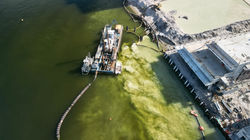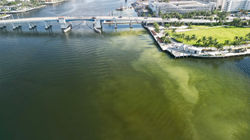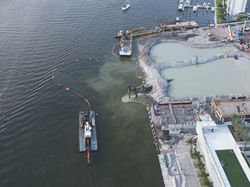IS IT SAFE TO
GO INTO THE WATER?
ON-GOING CONSTRUCTION POLLUTION
IN THE TARPON RIVER AND THE ICW
INTRACOASTAL WATERWAY
UPDATE!

TARPON RIVER
Good afternoon everyone,
-
Below are some of the current and past initiatives that have been undertaken in the Tarpon River:
2- Aerators have been installed in a section of the river where the Tarpon River intersects SW 4th Ave and SW 9th St.
3-Weekly waterway testing occurs at 3 locations by City staff.
4-City conducts waterway cleaning on a daily basis. The Tarpon River is serviced every two weeks with the last service being conducted on March 24th as shown by the below GPS screenshots. There are sections of the Tarpon River that are inaccessible due to water levels and bridge clearances that will not allow safe ingress or egress.
In 2020 an environmental assessment of a portion of the Tarpon River was done as a result of the force main breaks
And a portion was dredged in 2022.
Regarding Mr. R'S complaints, the City has been having an issue with a subcontractor (Solution Construction Inc.) who is doing some sewer work along the area of SW 7th St between SW 1st Ave and SW Flagler Ave. for the prime contractor Hanover Company who is constructing the Hanover Riverwalk at 477 SW 1st Ave.
The main issue has been the release of turbid discharges due to their dewatering into the Tarpon River. Environmental, Building Code Enforcement, and DSD – Engineering have been involved in the investigation. Ultimately a stop work order was issued until they could get their operation back into compliance. Fines were also assessed ($10,000) which they are appealing. They have been dewatering in compliance for about the past couple of weeks. There was a minor incident on April 7th, most of the turbidity was contained with the turbidity curtain which the City made them install to mitigate any discharges. The site will continue to be monitored and issues addressed. That part of the Tarpon does not flow very well so it is common to have water stagnate until some tidal exchange is experienced.
One of the other issues that we have been receiving feedback on are ‘remediation’ efforts for these types of discharges that Mr. Routman refers to. That would involve a much larger discussion to address from a practical, legal, etc. perspective. Currently, our mechanism for resolving these is to find the source which can be challenging in of itself and use enforcement available to us under City Code of Ordinances and the Florida Building Code.
Thank you!

On Wed, Apr 9, 2025 at 3:27 PM Suzee Bailey <info@residentsforresilience.org> wrote:
Thank you for the detailed information!
R4R would also like to express deep concern on behalf of our community regarding these ongoing and increasingly harmful impacts of construction activities on the Tarpon River, but also on the Intracoastal Waterway. These vital waterways are facing repeated disruptions caused by insufficient sediment controls, careless runoff, and, in some cases, a lack of regard for environmental safeguards.
Many of our residents are very concerned not only about the specific construction site at hand, but also the consistent sediment pollution at various construction sites both north and south of the Las Olas Bridge. They are particularly worried about potential health hazards associated with disturbed sediment that is released through faulty turbidity curtains or insufficient mitigation efforts.
According to the EPA, pathogens like bacteria, viruses, and parasites can attach to sediment particles and persist for extended periods. When sediment is disturbed, by storms or dredging, it can become airborne, allowing for the inhalation of contaminated particles and pathogens. This can lead to respiratory infections, allergic reactions, and other health issues. Additionally, legacy bacteria—often a result of past sewer line spills—can persist in sediment for years, contributing further to these concerns.
While turbidity is currently the only water quality monitoring required at this site and along the ICW, residents are understandably concerned about the broader impacts. These concerns have only grown since the City pulled Miami Waterkeeper’s independent monitoring off the Tarpon River, leaving a troubling gap in third-party oversight. Meanwhile, residents with boats docked near the construction zones have reported significant damage to their vessels due to sediment accumulation.
Despite existing ordinances, we continue to witness severe turbidity events, sediment accumulation, and contamination that threaten marine life, water quality, public health, and community trust. The current enforcement methods, which often involve minimal fines or warnings, have proven to be ineffective in deterring negligent practices.
We respectfully urge the Commission to take the following actions:
Increase and enforce meaningful fines, starting at a minimum of $10,000 per violation, with a maximum of $15,000, as allowed. The current $500 fines are insufficient and ineffective.
Issue immediate stop-work orders for any project violating environmental protections, with mandatory cleanup fully paid for by the construction company. The cleanup should be followed by independent water quality monitoring—not limited to turbidity, but also including broader indicators of ecological health to ensure the safety and welfare of all who live, work, or play on these waterways.
Require stricter sediment control and construction best practices, including properly functioning containment systems, storm preparation protocols, and stronger oversight of high-risk waterfront sites.
Establish a dedicated environmental compliance liaison or task force within the City’s Environmental or Building Department to monitor activity and address violations swiftly.
Ensure public transparency by making all permits, enforcement actions, fines, and water quality monitoring results easily accessible to residents and environmental watchdog groups in real time.
Our waterways are not only central to the identity and economy of Fort Lauderdale, but they are also vital ecosystems that must be protected. Continued inaction or leniency in enforcement threatens long-term damage, undermines restoration efforts, and sends the wrong message to developers.
We urge the City to act boldly and swiftly to protect these invaluable resources. Thank you for your time, leadership, and commitment to preserving Fort Lauderdale’s most important natural assets. We stand ready to support you in implementing these necessary improvements.
I have many pictures and videos that I can send upon your request!
Sincerely,
Suzee Bailey
 |  |  |  |
|---|---|---|---|
 |  |  |  |
 |  |  |  |
 |

Incidents like these have residents concerned, leading many to question,
"Where are the warning signs?"
FOR YOUR HEALTH AND SAFETY
Miami Waterkeeper test these 13 sites in our Fort Lauderdale Waterways for bacteria levels
WEEKLY BACTERIA WATERWAY MONITIORING RESULTS BELOW!
For your Health and Safety - All Waterway Recreational Activities should be avoided in areas that test over 70!

IS IT SAFE TO GO INTO OUR WATERWAYS?
According to marine water quality testing data provided by Miami Waterkeeper,
many test sites throughout Fort Lauderdale's waterways
are currently unsafe for recreational activities.
Any measurement exceeding 70 MPN (as you see above in the pink)
is considered risky and potentially dangerous.
High readings like these are often result from sewer line breaks or heavy rainfall.
However, many sites in the pink are on dates
with no recent sewer line break alerts and no heavy rainfall.
What is the exact causeof these concerning results?
Our R4R team has been requesting more informative safety signage in areas of our waterways that may be harmful for recreational activities.
Unfortunately this sign below
is what has been placed at a few sites that test frequently high:
We feel a more informative sign like this is needed.
Your thoughts?
Miami Waterkeeper conducts weekly bacteria level monitoring in Fort Lauderdale's waterways to keep you informed about water safety. You can easily access these results, along with the Department of Health's (DOH) Healthy Beaches testing data, through the free Swim Guide app or their website click here.
Both Miami Waterkeeper and the DOH perform water sampling every Monday morning, with the latest results available by Tuesday afternoon. If a site shows high bacteria levels, they are committed to re-testing daily until the issue is resolved.
The EPA has set the following standards for safe swimming water, which are used by DOH and Miami Waterkeeper:
0-70 CFU/MPN per 100 mL enterococci per sample: Safe for swimming
70+ CFU/MPN per 100 mL enterococci per sample: Not safe for swimming
Avoid waterway recreational activities
after heavy rain event.
Bacteria levels can become extremely high.





IS IT SAFE TO GO INTO THE WATER?
Did you know that you can use this SWIM GUIDE App to check waterway quality conditions before you go to the beach or on our waterways?


FOR MORE IN-DEPTH WATER QUAILITY DATA VISIT MIAMI WATERKEEPER WEBSITE - THEY ARE THE SCIENTIST WHO TEST 10 SITES OF OUR FORT LAUDERDALE WATERWAY
CLICK HERE



Why you want to avoid water sports after severe rains! 70 is the threshold




SIGNAGE IS RECOMENDED BY THE EPA!
Warning - no swimming because of high bacteria levels.
Children, the elderly and people with weakened immune systems are the most likely populations to develop illnesses or infections after coming into contact with polluted water, usually while swimming. Fortunately, while swimming-related illnesses are unpleasant, they are usually not very serious. They require little or no treatment or get better quickly upon treatment, and they have no long-term health effects.
The most common illness associated with swimming in water polluted by sewage is gastroenteritis. It occurs in a variety of forms that can have one or more of the following symptoms: nausea, vomiting, stomachache, diarrhea, headache or fever. Other minor illnesses associated with swimming include ear, eye, nose and throat infections. In highly polluted water, swimmers may occasionally be exposed to more serious diseases.
Another potential source of illness includes some types of cyanobacteria that form algal “blooms” (discolored water) and the toxins they produce. When people are exposed to cyanotoxins, they may have hay fever-like symptoms, skin rashes, sore throat, cough, nausea, vomiting, diarrhea, or even kidney or liver damage. Pets can be poisoned by drinking or swimming in toxin-contaminated water.





DID YOU KNOW MANGROVES ARE THE SUPERHEROES OF OUR ENVIRONMENT?

Along the coast of Southwest Florida, red tide is lingering. Through January 6, 2023, the Florida Fish and Wildlife Conservation Commission detected low to high concentrations in 59 samples collected from Pinellas to Charlotte County, as detailed in the image above.









